WW2 Soviet Destroyers
 Soviet Navy
Soviet Navy
About 5 classes, 65 ships 1911-1941
Soviet destroyers really knew two eras, the one which began in Imperial times with the formidable Novik own lineage and the one that started in 1936 with the first Soviet plan for mass-building a new generation of destroyers and a great void practically from 1916 to 1936, with the exception of a remarkable serie of lead destroyers (The Kievs). What could be said about these ?
On one hand the Novik were originally built in Germany on Russian specifications and were so outrageously powerful for their time, so much that they inaugurated a brand new escalade in speed, tonnage and armament, and the almost nimble, Italian-designed Gnevniy made its seems for the Mediterranean-like Black sea and Baltic, not for the Alantic or Pacific.
The Soviet fleet in 1921, when the civil war ended and counts were made, inherited the impressive stock of the Tsarist navy, one of the largest in the world. In fact practically all the old units had been lost in the turmoil of the civil war.
However, the fleet rehabilitated a number of units: In 1941, the fleet still aligned some of the Donskoi Kazak class ships, as well as other pre-Tsushima destroyers (reclassified as gunboats) and 16 of the famous Novik class starting from 1904 to 1916.
The heavy destroyers in service in 1941 were also known as “squadron leaders”, high-tonnage and well armed units in their category, sometimes even referred to as light cruisers. These were the 6 units of the Leningrad class and sole Taschkent.
The latter, contemporary of the Kirov, was also designed by the Italians, built in Livorno. She was hailed arguably as the most “beautiful” warship of the time. Other heavy destroyers of the same model as the Taschkent were to be produced in the USSR, the Kiev class, but they remained unfinished when the german captured these installations. Most standard destroyers in service came from the 1936 plan, of the Gnevnyi class which would comprise 31 units, and those of the Storozhevoi class (20 units), and the only Opytnyi.
The following Ognevoi class was much more modern, but the units were launched in 1940, two completed in 1944 and the others in 1945-48. This class had to include a first group of 24 units, but it seems that only 14 were started and laid up.
Sverdlov (Novik) class Destroyers (1911-16)
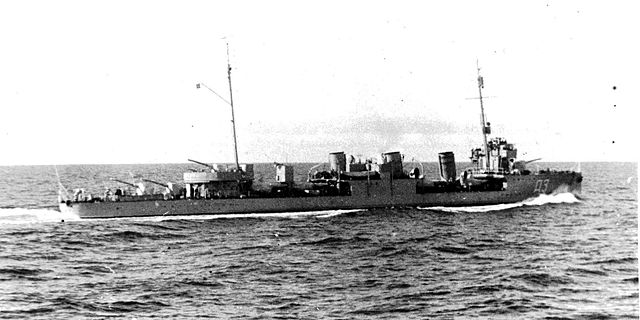
Destroyer Dzerzhinskiy underway during the interwar
When it first appareaed in naval reviews, the Novik made a sensation, as the most powerful destroyer and fastest ship in the world. She relegated overnight all “drestoyers” built at the same time to the rank of torpedo boats. The Novik was the prototype of four other classes, more than three quarters of which were sunk, destroyed or broken up after years of neglect at the end of the civil war. In 1939 only 16 of the initial 54 ships built were still in service (six of which were completed in 1923-28). But the military value of these ships was intact. They had all been renamed and rearmed with 37mm AA guns and 12.7 mm heavy machine guns to be kept up to date.
However, their 457 mm torpedo tubes and 102 mm pieces were a bit light to the light of the new Japanese Fubuki standard of 1936. Their new names were the Sverdlov (ex-Novik), Frunze, Karl Marx, Karl Libnecht, Rykov, Voikov, Engels, Urickiy, Artiom, Neziamozhniy, Shaumyan, Petrovskiy, Stalin, Volodarskiy, and Dzerzhinskiy. Survivors in 1943-44 received three 37mm and two 20mm AA cannons in addition. They could all carry and laid from 60 to 80 mines. Their torpedo tubes provision were most often reduced by a third or half to make way for this additional artillery and reclaim some stability. The last ships had only six of the original 12 tubes. In operations, six sank on mines in August 1941, another was sunk in June, and one in September, another in August. The survivors were removed from service in the early 1950s.

Profile of the Frunze in 1942, by the author
Specifications
Displacement: 1330t, 1400t Fully loaded
Dimensions: 102 x 9.50 x 3.20 m
Propulsion: 2 Parsons turbines, 5 Thornycroft boilers, 29 000 cv. 33 knots max.
Crew: 150
Armament: 4 x 102, 2 x 76, 2 x 37, 3 x 12,7 mm AA, 6 x 457 mm TTs, 80 mines.
Leningrad class destroyers leaders (1933)

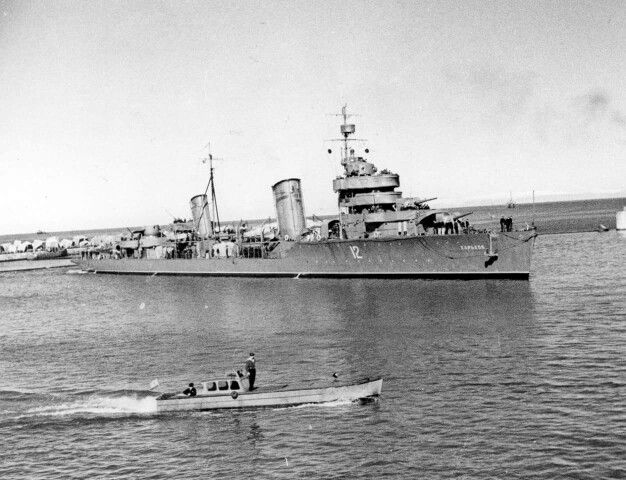
Top: Blueprint of the Baku. Bottom: Destroyer leader Kharkov.
The destroyers of the Leningrad class are the first ships of this type in Russia since the Novik of 1914-16. Expected to take the lead of the standard destroyer squadrons being designed, these powerful ships were designed under French influence: The Russians had been impressed by the heavy destroyers of the Aigle and Vauquelin class. Although they were not like them, these 6 ships were heavily armed, but they were slowly built (5 years for the first), because they were the first major military ships launched in the USSR since the disasters of the civil war. The armament was reinforced during the war with six 37 mm AA cannons, and they lost their 130 mm gun behind the bridge. Kharkov was bombed and lost in 1943, the Moskva was sank by mines in June 1941 off Romania, the others survived until the 1960s. The subject will be treated soon more in detail like the Tashkent.

Destroyer Leningrad, author’s illustration
Specifications
Displacement: 2150t, 2582t PC;
Dimensions: 127,50 x 11.70 x 4.20 m
Propulsion: 3 turbines, 3 watertube boilers, 66,000 cv. 36 knots
Crew 250
Armament: 5 x 130, 2 x 76, 2 x 45 AA, 8 x 533 mm TTs (2×4), 80 mines.
Tashkent (1937)
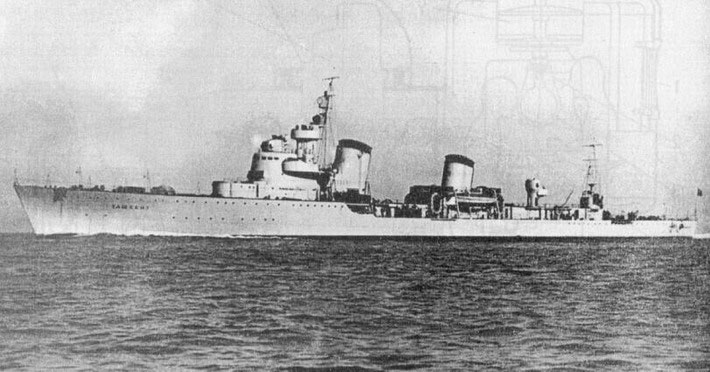
The Tashkent was the prototype of a new class of large destroyers built in Italy. When delivered she was only stunningly handsome but also painted in a brand new experimental light blue paint and therefore known as “blue beauty”, from OTO shipyard in Livorno. On the technical side, she was an excellent ship, capable of 44 knots on trials. She sailed to the balck sea without armament for political reasons, but was supplied with a transitional armament of 4 x 130 mm, replaced later by new twin turrets in 1940. She was hit badly by the Luftwaffe ans later sank in Novorrossisk, paret of the turrets being recovered for the destroyer Ognevoi. She was refloated in 1942 by the Germans to be broken up, but this was acted in 1943-44 when recaptured. More about it

Kiev class Super-destroyers (1940)
The series that followed the Tashkent, a “super destroyer” comparable to the French Mogador, the Kiev class, drifted closely but the built ships were never completed because of the German invasion. Two were destroyed on slip and the hulls of the two others were taken to Poti to avoid capture. They were broken up in 1946.
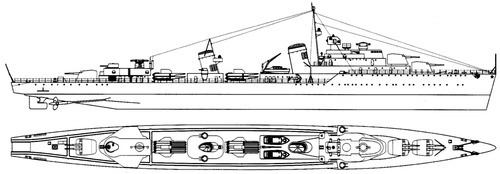
Project 48 Kiev class leader destroyer blueprint
Gnevnyi class destroyers (1936)
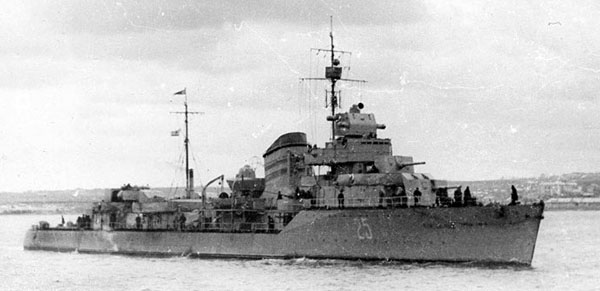
Bditelnyy
This class of mass destroyers (31 ships) also called standard (type 7) and a sub-class were developed with the same design to save time and money. They were the first destroyers built in the USSR since the Novik of 1914-18. Italian engineers participated in their development. For the rest, they were fairly classic ships, small in size but still with a powerful armament, but they inherited from their original Italian design structural rigidity defencts and perfectible high-sea behavior. Two of them were converted to standard 7U, their reinforced hulls and improved machines to compensate for weight gain. They ended up in the Storozhevoi class.
These 31 units were all in service in June 1941, the last one, Rekordnyi, being launched the same year. The others were between 1936 and 1940. Their AA armament was reinforced by three or four 37 mm AA cannons during the war. 12 were lost in action war and four were later transferred to China. It is possible that the Reshitelnyi was stranded in November 1938. The survivors were stricken from the lists in the 1950s.
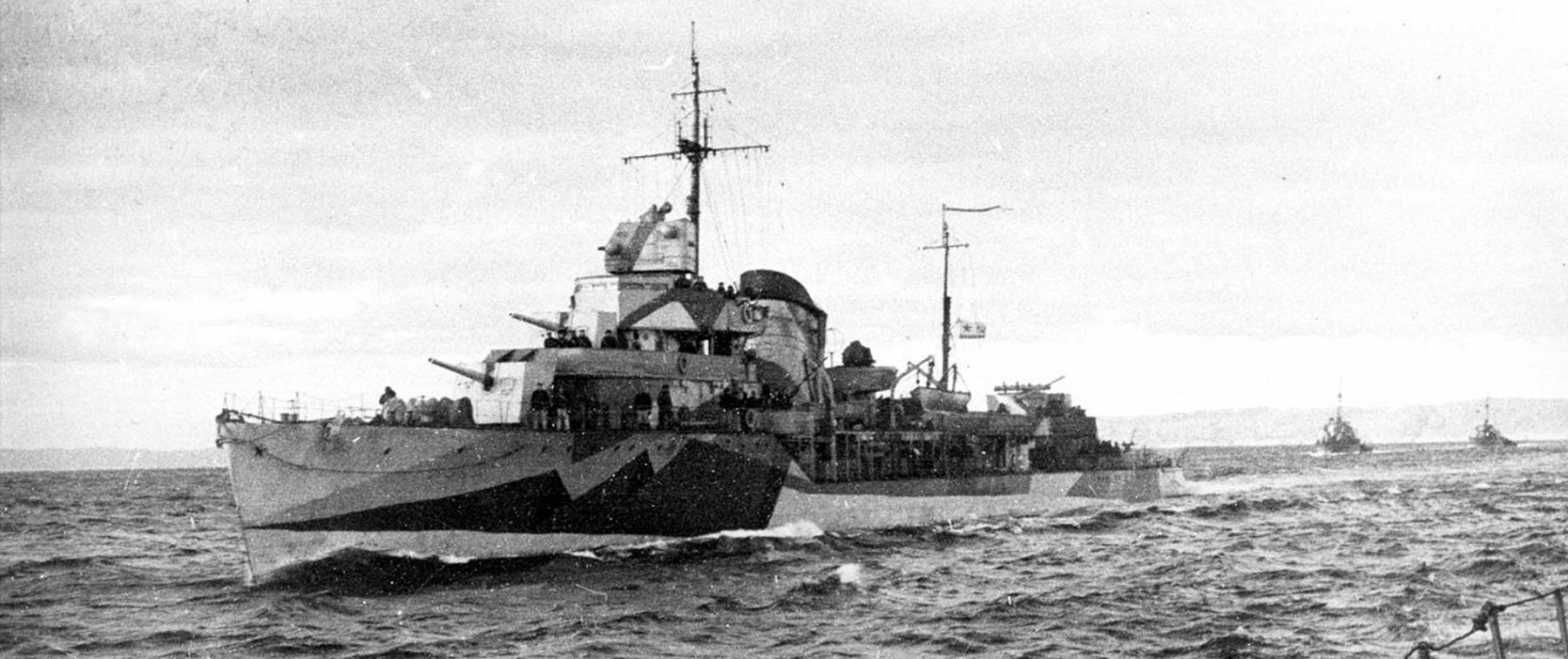
Groznyy 1942

Gnevnyy 1940, author’s illustration
Gnevnyy Specifications
Displacement: 1855t, 2380t Fully Loaded
Dimensions: 112,80 x 10.20 x 4.10 m
Propulsion: 2 Parsons turbines, 3 watertube boilers, 48 000 cv. 37 knots.
Crew: 734
Armement: 4 x 130, 2 x 76, 2 x 45 AA, 4 x 12,7 HMG AA, 6 x 533 mm TTs (2×3), 56 mines.
Storozhevoi class destroyers (1938)

Smyshlenyy at full speed
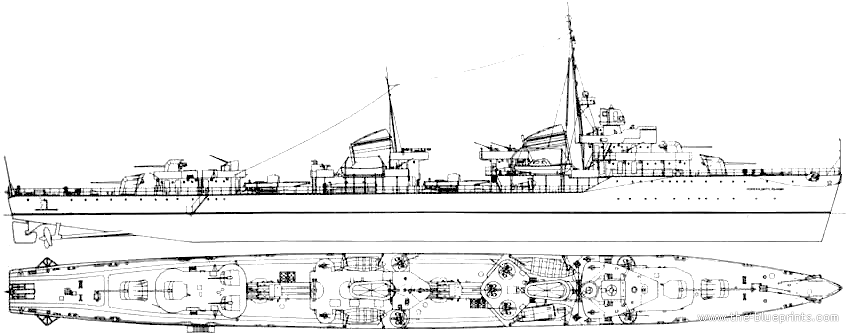
Soobrazitelny 1943 project-7u destroyer
Type 7U was a general upgrade of Type 7 (Gevnyi), with a reinforced hull, better protection and more powerful turbines, two boilers, and better AA weaponry (faster 37mm guns rather than the traditional 45s.). 20 will be programmed and started, started in 1938-39 and 18 will come into service in 1939-40. During the conflict, they received 37mm AA guns and additional machine guns (standard in 1944: 7 37mm guns, 8 machine guns, some equipped with radar and ASDIC in 1945, of American origin. Of the total, 3 will be captured and scuttled in 1940-41, 4 lost in July and August 1941, 4 others will jump on mines, 3 will be torpedoed and 2 bombed in 1942-43. In 1945, there were only 7. They were deactivated in the 1950s, the Sobrazitelnyi becoming a museum in 1966.

Storozhevoi author’s illustration
Storozhevoi Specifications
Displacement: 2192t, 2404t FL
Dimensions: 112,80 x 10.20 x 4.10 m
Propulsion: 2 turbines, 4 chaudières à tube d’eau, 54 000 cv. et 36 noeuds max.
Crew: 207
Armament: 4 x 130, 2 x 76, 3 x 37 AA, 4 x 12,7 mm HMG, 6 x 533 mm TTs (2×3), 60 mines.
Opytnyi (1939)
This unique experimental ship launched in 1935 at the Zhdanov shipyard, the first modern Soviet destroyer designed without outside assistance (especially Italian expertise). He had to be much lighter and faster than the Gnevnyi. Indeed, for larger dimensions (118×11,60m against 112,8×10,20m), he claimed 4000 tons less. But this was detrimental to the strength of his hull, and although the tests, which continued until the end of 1941, it reached 42.6 knots, its artillery was almost unusable at these speeds because of too strong vibrations. She survived the war and was removed from service in the 1950s.

Opytnyi, author’s illustration
Opytnyi Specifications
Displacement: 1670t, 1870t FL
Dimensions: 118 x 10.60 x 4.20 m
Propulsion: 2 props. 2 turbines, 4 Ramsin boilers, 70,000 cv. 42 knots.
Crew: 197
Armament: 3 canons de 130, 4 canons de 45 et 3 canons 37 mm AA, 4 ML 12,7, 8 TLT 533 mm ( 2×4 ), 60 mines.
Ognevoi class destroyers (1940)
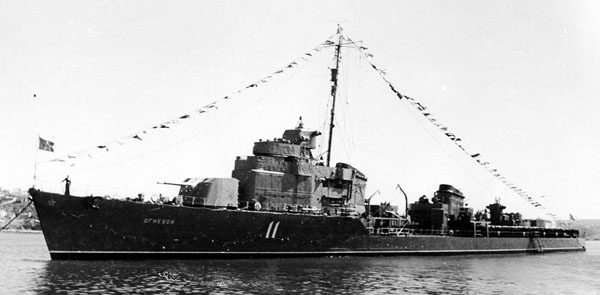
This last class of Soviet destroyers prior to the Cold War was intended to replace previous mass production vessels by maintaining their rigidity, but by providing additional space for fuel oil, increasing their autonomy. Efforts were made to improve their stability and good behavior in heavy weather, and although this was a standard, they were particularly intended for the Pacific fleet, in order to meet the Japanese units. Their two double turrets were of a Russian model, but on the Ognovoi, they came from the heavy Tashkent destroyer, sunk by the Luftwaffe. 24 units had been scheduled for the program, all but one being put on hold before the invasion. Only two were completed before the end of the hostilities, 12 others after the war, and the others demolished in their basins. The destroyers of the Skoryi class, the most produced by the Soviet Union during the Cold War, derived directly from it.

Ognevoi, author’s illustration
Ognevoi Specifications
Displacement: 2240t, 2950t Fully Loaded
Dimensions: 117 x 11 x 4.20 m
Propulsion: 2 props. 2 turbines, 4 watertube boilers, 54,000 hp, 37 knots.
Crew: 250
Armament: 4 x 130, 2 x 75 et 3 x 37 mm AA, 4 x 12,7 HMG, 6 x 533 mm TTs (2×3), 96 mines.
Sources; read More
Conway’s all the world fighting ships 1906-1921, 1922-1946
On navypedia.org
On wunderwaffe.narod.ru
Soviet destroyerYakov – Sverdlov
Soobrazitelnyy-class_destroyer
Ognevoy-class_destroyer
Gnevny-class_destroyer

 Latest Facebook Entry -
Latest Facebook Entry -  X(Tweeter) Naval Encyclopedia's deck archive
X(Tweeter) Naval Encyclopedia's deck archive Instagram (@navalencyc)
Instagram (@navalencyc)





 French Navy
French Navy Royal Navy
Royal Navy Russian Navy
Russian Navy Armada Espanola
Armada Espanola Austrian Navy
Austrian Navy K.u.K. Kriegsmarine
K.u.K. Kriegsmarine Dansk Marine
Dansk Marine Nautiko Hellenon
Nautiko Hellenon Koninklije Marine 1870
Koninklije Marine 1870 Marinha do Brasil
Marinha do Brasil Osmanlı Donanması
Osmanlı Donanması Marina Do Peru
Marina Do Peru Marinha do Portugal
Marinha do Portugal Regia Marina 1870
Regia Marina 1870 Nihhon Kaigun 1870
Nihhon Kaigun 1870 Preußische Marine 1870
Preußische Marine 1870 Russkiy Flot 1870
Russkiy Flot 1870 Svenska marinen
Svenska marinen Søværnet
Søværnet Union Navy
Union Navy Confederate Navy
Confederate Navy Armada de Argentina
Armada de Argentina Imperial Chinese Navy
Imperial Chinese Navy Marinha do Portugal
Marinha do Portugal Mexico
Mexico Kaiserliche Marine
Kaiserliche Marine 1898 US Navy
1898 US Navy Sovietskiy Flot
Sovietskiy Flot Royal Canadian Navy
Royal Canadian Navy Royal Australian Navy
Royal Australian Navy RNZN Fleet
RNZN Fleet Chinese Navy 1937
Chinese Navy 1937 Kriegsmarine
Kriegsmarine Chilean Navy
Chilean Navy Danish Navy
Danish Navy Finnish Navy
Finnish Navy Hellenic Navy
Hellenic Navy Polish Navy
Polish Navy Romanian Navy
Romanian Navy Turkish Navy
Turkish Navy Royal Yugoslav Navy
Royal Yugoslav Navy Royal Thai Navy
Royal Thai Navy Minor Navies
Minor Navies Albania
Albania Austria
Austria Belgium
Belgium Columbia
Columbia Costa Rica
Costa Rica Cuba
Cuba Czechoslovakia
Czechoslovakia Dominican Republic
Dominican Republic Haiti
Haiti Hungary
Hungary Honduras
Honduras Estonia
Estonia Iceland
Iceland Eire
Eire Equador
Equador Iran
Iran Iraq
Iraq Latvia
Latvia Liberia
Liberia Lithuania
Lithuania Mandchukuo
Mandchukuo Morocco
Morocco Nicaragua
Nicaragua Persia
Persia San Salvador
San Salvador Sarawak
Sarawak Uruguay
Uruguay Venezuela
Venezuela Zanzibar
Zanzibar Warsaw Pact Navies
Warsaw Pact Navies Bulgaria
Bulgaria Hungary
Hungary

 Bundesmarine
Bundesmarine Dutch Navy
Dutch Navy Hellenic Navy
Hellenic Navy Marina Militare
Marina Militare Yugoslav Navy
Yugoslav Navy Chinese Navy
Chinese Navy Indian Navy
Indian Navy Indonesian Navy
Indonesian Navy JMSDF
JMSDF North Korean Navy
North Korean Navy Pakistani Navy
Pakistani Navy Philippines Navy
Philippines Navy ROKN
ROKN Rep. of Singapore Navy
Rep. of Singapore Navy Taiwanese Navy
Taiwanese Navy IDF Navy
IDF Navy Saudi Navy
Saudi Navy Royal New Zealand Navy
Royal New Zealand Navy Egyptian Navy
Egyptian Navy South African Navy
South African Navy






























 Ukrainian Navy
Ukrainian Navy dbodesign
dbodesign